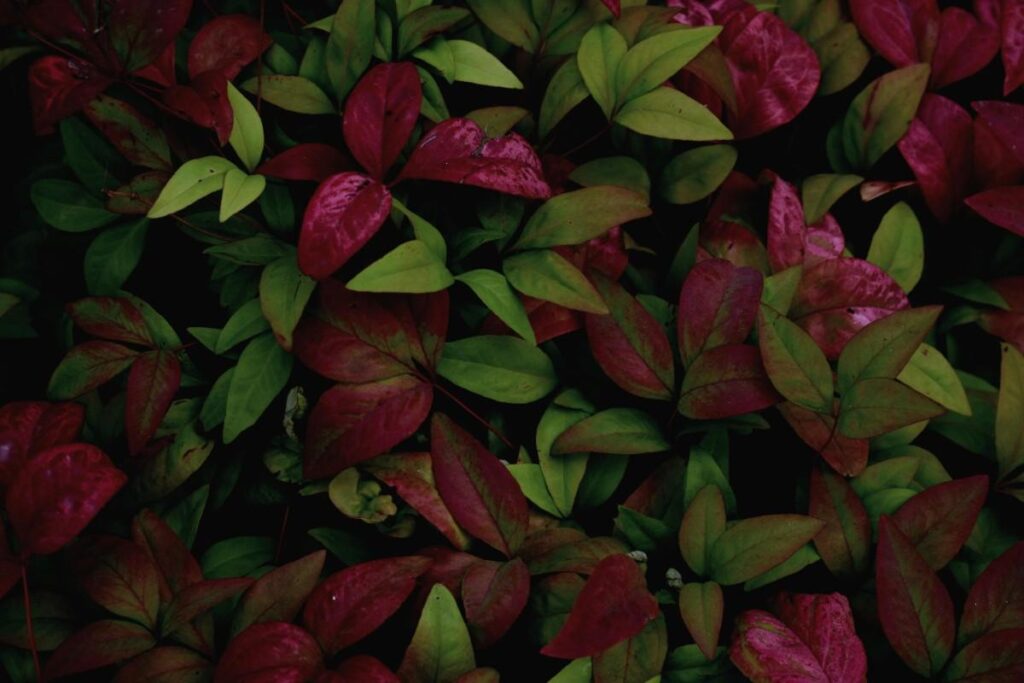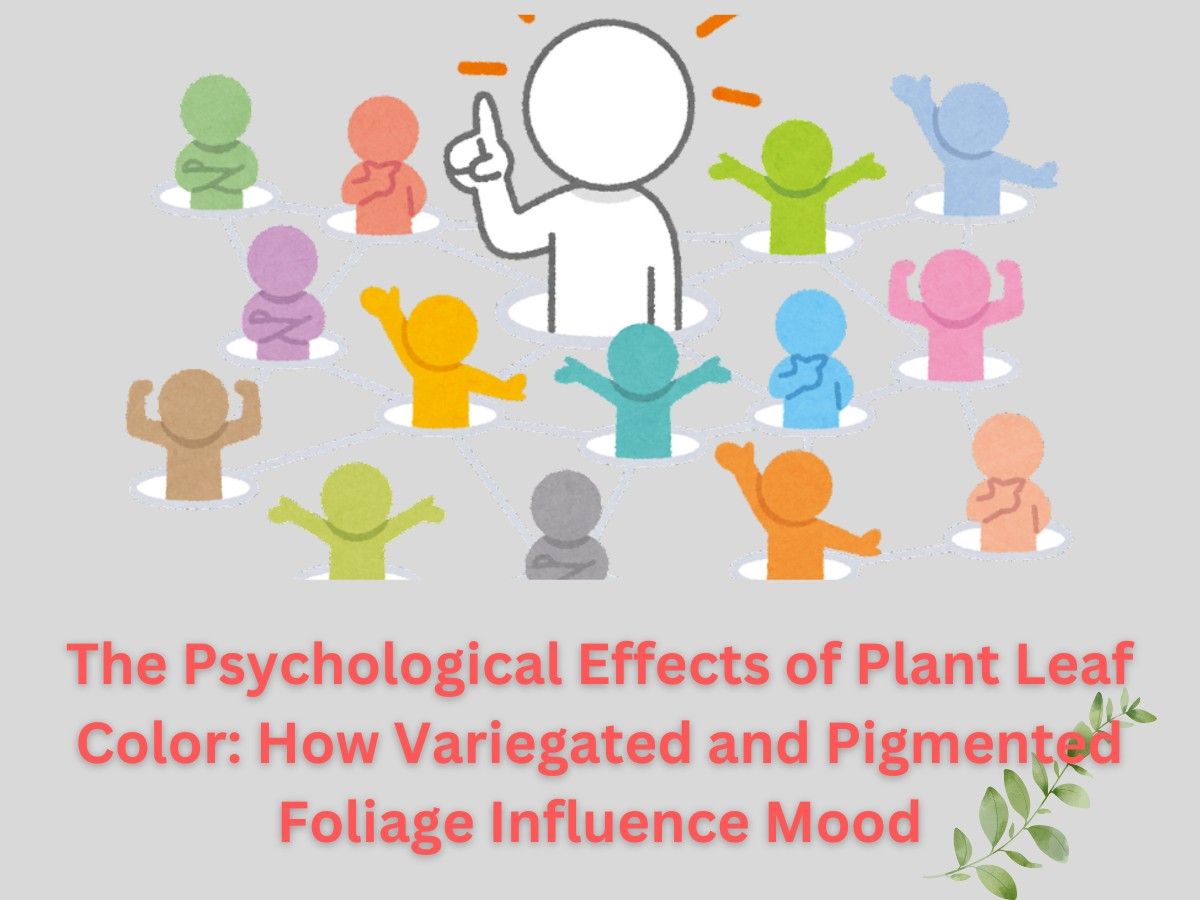Exploring How Variegated and Pigmented Foliage Influence Mood
Plants used indoors create design enhancements but they also powerfully affect how both our minds and emotions feel. With their multiple-color and pattern variations the leafage of plants functions to modify both setting atmospheres and emotional states. Fundamental knowledge about how foliage variegation and pigmentation affects emotions enables us to select plants strategically for building areas that bring energy, relaxation or inspiration. This study focuses How Variegated and Pigmented Foliage Influence Mood on the psychological effects that various plant leaf colors create while explaining their power to convert interior areas into tranquil positivity centers.

Key Insights: How Variegated and Pigmented Foliage Influence Mood
1. Calming Effects of Green Variegation
2. Stimulating Bright Pigments
3. Soft Tones for Relaxation
4. Contrast and Visual Interest
5. Impact on Focus and Productivity
6. Mood Brightening Through Diversity
7. Connection to Nature
8. Cultural Perceptions of Color
9. Therapeutic Effects of Observing Patterns
10. Customization of Indoor Atmosphere
1. Calming Effects of Green Variegation
Variegated green plants impose a calming effect which brings harmony and balance to domestic areas. Light/dark green variegations in foliage produce natural-seeming patterns that create mental relaxation and stress reduction. Green variegated plants create this relaxing atmosphere best in living rooms alongside bedrooms to target relaxation goals.
Studies confirm that viewing green tones helps the body lower stress hormones like cortisol and gives people a more peaceful feeling. Variegated green leaves create visual appeal while establishing peaceful indoor environments both attactively and naturally.
Variegated foliage maintains a central position among mood influences because green variegation proves to be especially critical. Man Made environments featuring green variegated foliage combine realistic landscapes with indoor space to keep people connected with nature from their window sills. Using green variegated plants as decoration in meditation or yoga spaces will enhance their ability to create calm surroundings.
A close look at green variegation patterns leads to observation periods that enhance mindfully disengaging from daily stress. People find emotional relaxation through centered leaf study because leaf patterns direct attention toward mental clarity thus demonstrating unique therapeutic aspects of pigmented and variegated foliage.
2. Stimulating Bright Pigments
Highly distinct foliage coloration featuring reds, oranges and yellows provided robust capability to boost the energetic quality of enclosed settings. The eye-catching colors of these hues activate brain signals that produce heightened alertness while lifting mood levels so they should be used to support energetic spaces like home offices and gyms.
Most people understand how warm hues impact our psychological well-being. The color red creates excitement from passion although yellow brings optimism to spaces. Green variegated foliage together with varied colors releases focused energy that does not feel overwhelming to users. Strategic placement of colorful plants becomes possible through an understanding of how both colored foliage and variegation impact human mood patterns.
Severely pigmented plants perform as core accent furnishings in home interiors which creates activity centers when people need to do things. A connection with bright pigments between plants and humans produces motivation alongside creativity within work environments. People who assess how diverse plant colors and patterns affect their feelings can design spaces which optimize productivity and happiness.
Your mental energy along with your mood will increase as you freely incorporate colorful blooms in your home plant traditions instead of using traditional artificial hues.
3. Soft Tones for Relaxation
Soft pastel-colored plants featuring light pink or cream or lavender leaves make excellent choices for establishing relaxed tranquil spaces. Soothing pastel-colored plants ease the mind and deliver maximum anxiety-relief. Green leaf variegation when combined with pastel coloring enhances relaxation features which turns locations into peaceful welcoming areas.
Pastel-colored foliage offers the distinct advantage of hidden integration in all types of interior settings ranging from minimalist to bohemian design. These adaptable plants work remarkably well when placed in areas designed for relaxation including bedrooms and reading nooks. The investigation of how foliage with both colors and patterns affects emotions demonstrates the necessity to pick select shades that match different emotional requirements.
Soft diffused light is reflected by pastel-colored foliage thus creating additional relaxation benefits. When pastel variegated plants receive natural light at strategic locations they create a gentle ambient glow with relaxing properties. Foliage with variegated and pigmented color schemes transforms beam and hue into devices which create mood relaxation.
Decorating your indoor space with pastel foliage helps you create environments dedicated to mindfulness and emotional health improvement.
4. Contrast and Visual Interest
Indoor spaces become more energetic when variegated foliage presents opposing color combinations creating visual stimulation alongside dynamism. The power of contrasting leaf features works through dark green bases highlighting creamy white edges and bright yellow markings which direct viewers to deepen their involvement with environmental surroundings. The more we interact with plants the greater our creative thinking becomes while sensations of monotony decrease.
Studies into variegated and pigmented foliage show that complex visuals lead to stronger emotional stimulation processes. Plants with variegation combined with strong color contrasts have the power to convert uninteresting areas into lively colorful environments. Polarized foliage works best in areas including home offices and creative studios which need mental activation as a top priority.
The interesting patterns of variegated foliage duplicate natural landscape diversity that sparks investigative thinking. Supplemental contact with nature rejuvenates emotional states as well as mental outlook because it enhances mood which strengthens favorably as we see the effects on mood in regular environments.
Plants displaying strong color variations help you design an eye-catching interior setting which simultaneously stimulates creativity while maintaining mental concentration.
5. Impact on Focus and Productivity
Foliage featuring cool pigmented shades of purple and blue generates increased concentration levels and better mental focus according to researchers. The shades fill work environments and study spaces because they bring both peaceful emotions and mental stimulation benefits. The combination of these elements produces a discreet method for enhancing mental clarity.
People experience psychological stability and organizational effects when they encounter blue and purple colors. These colors serve people working under stress or needing extended concentration periods exceptionally well. Homeowners who study the effects that variegated and pigmented foliage have on moods can design work-compatible spaces which enhance productivity in addition to mental health.
Cool-toned foliage elements blend perfectly with natural wood and neutral decor features which create an attractive layout and help maintain work focus. By successfully combining plants with different colors designers showcase how foliage combinations impact mood in functional methods.
Installing cool-toned variegated plants in your workspace produces critical changes to both your concentration abilities and work performance throughout the daily work hours.
6. Mood Brightening Through Diversity
Plants with varying colors produce dynamic environments which fight off dullness and monotony. When used in monotonous uninspiring spaces the colorful patterned design interaction becomes a proven technique to lift mood levels.
The study of foliage coloring and leaf pattern dynamics demonstrates that plant diversity effectively reproduces natural outdoor environments and affects human emotional responses. Mixed plant patterns excite our feelings and introduce exciting personality to indoor spaces beyond simple monotonous decor. Yellow variegated plants when placed next to deep purple leaves create a balanced cheerful landscape.
Different plant colors help people interact better with the environmental surroundings. Living rooms and dining areas benefit from colorful patterned plant arrangements because human nature reveals an automatic attraction to these visually engaging arrangements. Scientific research shows that combining various colorful foliage plants with their distinctive patterns will both elevate mood levels and create welcoming indoor environments.
Selecting different types of colorful plants for your home enables you to shape spaces that promote both good feelings and positivity between nature and your home interior.
7. Connection to Nature
Plants featuring variegated and multiple coloration help people maintain a feeling of connection with nature which studies show minimizes stress while encouraging mindfulness. Our environment benefits from leaf-like leaves which exhibit varied natural patterns together with colors from alight green to vivid red thus supplying mental calmness and steadiness.
People naturally react to nature because their brains innately seek these patterns through biophilia and the influence it has on mood. Your home interior connects to outdoor spaces when you bring these plants indoors because they create an emotional connection that improves mental wellness.
Our homes become more visually rich through natural plant color variations which provide intricate textures and develop authentic organic life. When we connect with nature through colorful foliage we experience relaxation through mood management alongside lower anxiety as we follow a typically mindful path in life. These effects show how decorative foliage shapes our emotional state.
Plants that preserve natural beauty serve as home design elements which establish peaceful sanctuary vibes.
8. Cultural Perceptions of Color
The way foliage colors affect human mental state varies widely according to what different societies understand color to mean. In different cultural contexts red foliage represents favorable luck or good financial fortune to some groups yet shows emotional power or vibrant vitality to others. Plant color received through cultural associations influences how people react to and view various plant colors.
Mood transformations triggered by variegated and pigmented foliage require deep consideration of location-based color traditions. White variegated patterns convey peaceful and pure impressions throughout Western societies yet these features symbolize mourning throughout some Eastern cultures. In many cultures yellow and gold tones symbolize hopeful resources and associated prosperity so they prove to be ideal choices for communal spaces.
Homeowners can make decisions about plant selections by assessing cultural meanings to find foliage options that express their personal values through the use of pigmented and variegated elements. Planned plant choices that reflect specific cultural meanings create more purposeful design elements that enhance views of foliage according to personal cultural values.
9. Therapeutic Effects of Observing Patterns
The complex contemplative geometry found in different foliage produces a quieting effect which reduces anxiety and triggers happy feelings. Looking at leaf patterns in nature leads people toward a mindful state while simultaneously distracting them from their stress.
The visual attention patterns in variegated and pigmented foliage functions as a psychological anchor leading people to resistance of negative thoughts while promoting serenity. The patterns help people manage anxiety alongside creating a peaceful meditation experience that suits daily routines.
Sets of variegated plants which display unique patterns should be positioned in busy zones to silently prompt mindfulness experiences. The beneficial elements of natural colors in combination with focused mental moments demonstrate how leaf variegation shapes mood results that matter coupled with daily functionality.
Plants with complex designs serve as a tool for designing spaces which support both mental wellness and emotional equilibrium.
10. Customization of Indoor Atmosphere
Indoor spaces achieve endless emotional room customization through the usage of plants with patterned colors. The combination of foliage color and patterns creates a flexible tool that enables people to choose between calming and energizing moods for any space.
Owners who grasp how foliage color patterns affect moods gain valuable tools to apply plants for deeper interior design functions. Plants featuring dark red color pigments will energize a space although pastel petals on leaves create relaxing spa environments.
Plants which homeowners can place and relocate across their space provide unique opportunities to adjust the room ambiance based on desired moods. The flexible nature of plants with variegation and pigmentation gives homeowners the ability to adjust interior design according to their shifting emotional needs and seasonal preferences.
Using the different characteristics of variegated and pigmented plants you can create a customized indoor environment that suits your needs and improves your overall health.
How Variegated and Pigmented Foliage Influence Mood
Plant leaf colors function as a conceptual display of how natural elements can develop mental and emotional states. Your living space receives powerful enhancement through the placement of appropriate colorful leaves which include either relaxing green patterns or energizing vivid colors. Knowledge of foliage mental effects enables you to create indoor plant selections based on mood objectives and visual intentions. Introducing various colorful leafed plants to your space will create a wellness sanctuary full of happy moments.
6 FAQs About How Variegated and Pigmented Foliage Influence Mood
Are variegated plants effective for enhancing mental health?
The appearance of variegated plants adapts natural patterns which create both mindfulness and relaxation through their stress and anxiety reduction properties.
Which pigmented plant types provide the best outcome for energy enhancement?
The pigmented foliage of Croton and Coleus as well as red and yellow and orange plants will establish vibrant energetic spaces.
Do plants with colored pigment need dedicated maintenance beyond what normal green plants need?
Foliage with pigments requires increased exposure to sunlight to prevent fading yet follows regular horticultural practices similarly to standard plants.
Which variegated plants should I place in my space to create relaxation?
Green and pastel variegated plants should be strategically placed under natural soft lighting for creating soothing environments.
Do colorful plants have any impact on workplace productivity levels?
Plants featuring cool pigment tones in blue or purple help individuals focus better while working or studying at specific locations.
Does every indoor environment have space for variegated plants?
Positioning variegated plants depends on lighting requirements as well as furniture arrangement to get the best visual effect.




